engine Alfa Romeo 166 2006 Owner handbook (in English)
[x] Cancel search | Manufacturer: ALFA ROMEO, Model Year: 2006, Model line: 166, Model: Alfa Romeo 166 2006Pages: 272, PDF Size: 4.17 MB
Page 141 of 272
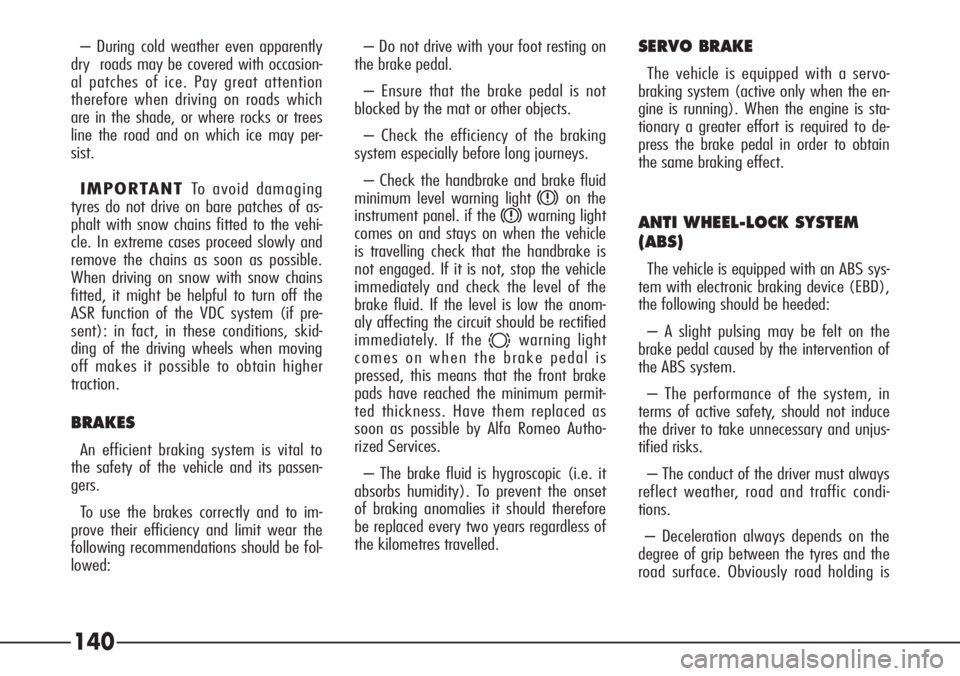
140
– During cold weather even apparently
dry roads may be covered with occasion-
al patches of ice. Pay great attention
therefore when driving on roads which
are in the shade, or where rocks or trees
line the road and on which ice may per-
sist.
IMPORTANT To avoid damaging
tyres do not drive on bare patches of as-
phalt with snow chains fitted to the vehi-
cle. In extreme cases proceed slowly and
remove the chains as soon as possible.
When driving on snow with snow chains
fitted, it might be helpful to turn off the
ASR function of the VDC system (if pre-
sent): in fact, in these conditions, skid-
ding of the driving wheels when moving
off makes it possible to obtain higher
traction.
BRAKES
An efficient braking system is vital to
the safety of the vehicle and its passen-
gers.
To use the brakes correctly and to im-
prove their efficiency and limit wear the
following recommendations should be fol-
lowed:– Do not drive with your foot resting on
the brake pedal.
– Ensure that the brake pedal is not
blocked by the mat or other objects.
– Check the efficiency of the braking
system especially before long journeys.
– Check the handbrake and brake fluid
minimum level warning light
xon the
instrument panel. if the
xwarning light
comes on and stays on when the vehicle
is travelling check that the handbrake is
not engaged. If it is not, stop the vehicle
immediately and check the level of the
brake fluid. If the level is low the anom-
aly affecting the circuit should be rectified
immediately. If the
dwarning light
comes on when the brake pedal is
pressed, this means that the front brake
pads have reached the minimum permit-
ted thickness. Have them replaced as
soon as possible by Alfa Romeo Autho-
rized Services.
– The brake fluid is hygroscopic (i.e. it
absorbs humidity). To prevent the onset
of braking anomalies it should therefore
be replaced every two years regardless of
the kilometres travelled.
SERVO BRAKE
The vehicle is equipped with a servo-
braking system (active only when the en-
gine is running). When the engine is sta-
tionary a greater effort is required to de-
press the brake pedal in order to obtain
the same braking effect.
ANTI WHEEL-LOCK SYSTEM
(ABS)
The vehicle is equipped with an ABS sys-
tem with electronic braking device (EBD),
the following should be heeded:
– A slight pulsing may be felt on the
brake pedal caused by the intervention of
the ABS system.
– The performance of the system, in
terms of active safety, should not induce
the driver to take unnecessary and unjus-
tified risks.
– The conduct of the driver must always
reflect weather, road and traffic condi-
tions.
– Deceleration always depends on the
degree of grip between the tyres and the
road surface. Obviously road holding is
Page 142 of 272
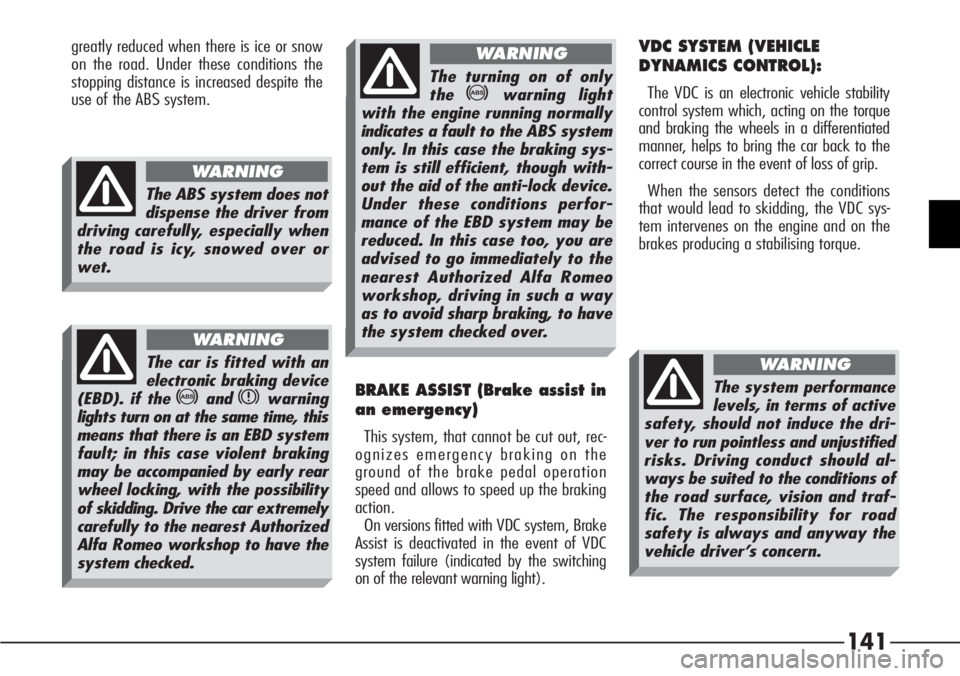
141
greatly reduced when there is ice or snow
on the road. Under these conditions the
stopping distance is increased despite the
use of the ABS system.VDC SYSTEM (VEHICLE
DYNAMICS CONTROL):
The VDC is an electronic vehicle stability
control system which, acting on the torque
and braking the wheels in a differentiated
manner, helps to bring the car back to the
correct course in the event of loss of grip.
When the sensors detect the conditions
that would lead to skidding, the VDC sys-
tem intervenes on the engine and on the
brakes producing a stabilising torque.
BRAKE ASSIST (Brake assist in
an emergency)
This system, that cannot be cut out, rec-
ognizes emergency braking on the
ground of the brake pedal operation
speed and allows to speed up the braking
action.
On versions fitted with VDC system, Brake
Assist is deactivated in the event of VDC
system failure (indicated by the switching
on of the relevant warning light).
The ABS system does not
dispense the driver from
driving carefully, especially when
the road is icy, snowed over or
wet.
WARNING
The car is fitted with an
electronic braking device
(EBD). if the
>andxwarning
lights turn on at the same time, this
means that there is an EBD system
fault; in this case violent braking
may be accompanied by early rear
wheel locking, with the possibility
of skidding. Drive the car extremely
carefully to the nearest Authorized
Alfa Romeo workshop to have the
system checked.
WARNING
The turning on of only
the
>warning light
with the engine running normally
indicates a fault to the ABS system
only. In this case the braking sys-
tem is still efficient, though with-
out the aid of the anti-lock device.
Under these conditions perfor-
mance of the EBD system may be
reduced. In this case too, you are
advised to go immediately to the
nearest Authorized Alfa Romeo
workshop, driving in such a way
as to avoid sharp braking, to have
the system checked over.
WARNING
The system performance
levels, in terms of active
safety, should not induce the dri-
ver to run pointless and unjustified
risks. Driving conduct should al-
ways be suited to the conditions of
the road surface, vision and traf-
fic. The responsibility for road
safety is always and anyway the
vehicle driver’s concern.
WARNING
Page 143 of 272
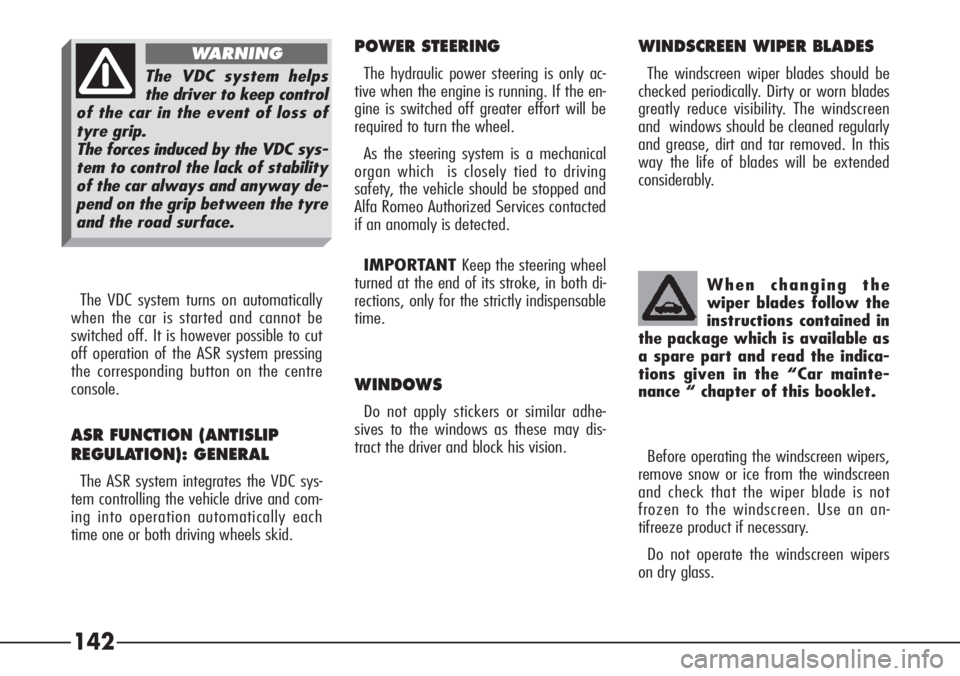
142
POWER STEERING
The hydraulic power steering is only ac-
tive when the engine is running. If the en-
gine is switched off greater effort will be
required to turn the wheel.
As the steering system is a mechanical
organ which is closely tied to driving
safety, the vehicle should be stopped and
Alfa Romeo Authorized Services contacted
if an anomaly is detected.
IMPORTANT Keep the steering wheel
turned at the end of its stroke, in both di-
rections, only for the strictly indispensable
time.
WINDOWS
Do not apply stickers or similar adhe-
sives to the windows as these may dis-
tract the driver and block his vision. The VDC system turns on automatically
when the car is started and cannot be
switched off. It is however possible to cut
off operation of the ASR system pressing
the corresponding button on the centre
console.
ASR FUNCTION (ANTISLIP
REGULATION): GENERAL
The ASR system integrates the VDC sys-
tem controlling the vehicle drive and com-
ing into operation automatically each
time one or both driving wheels skid.When changing the
wiper blades follow the
instructions contained in
the package which is available as
a spare part and read the indica-
tions given in the “Car mainte-
nance “ chapter of this booklet.
WINDSCREEN WIPER BLADES
The windscreen wiper blades should be
checked periodically. Dirty or worn blades
greatly reduce visibility. The windscreen
and windows should be cleaned regularly
and grease, dirt and tar removed. In this
way the life of blades will be extended
considerably.The VDC system helps
the driver to keep control
of the car in the event of loss of
tyre grip.
The forces induced by the VDC sys-
tem to control the lack of stability
of the car always and anyway de-
pend on the grip between the tyre
and the road surface.
WARNING
Before operating the windscreen wipers,
remove snow or ice from the windscreen
and check that the wiper blade is not
frozen to the windscreen. Use an an-
tifreeze product if necessary.
Do not operate the windscreen wipers
on dry glass.
Page 150 of 272
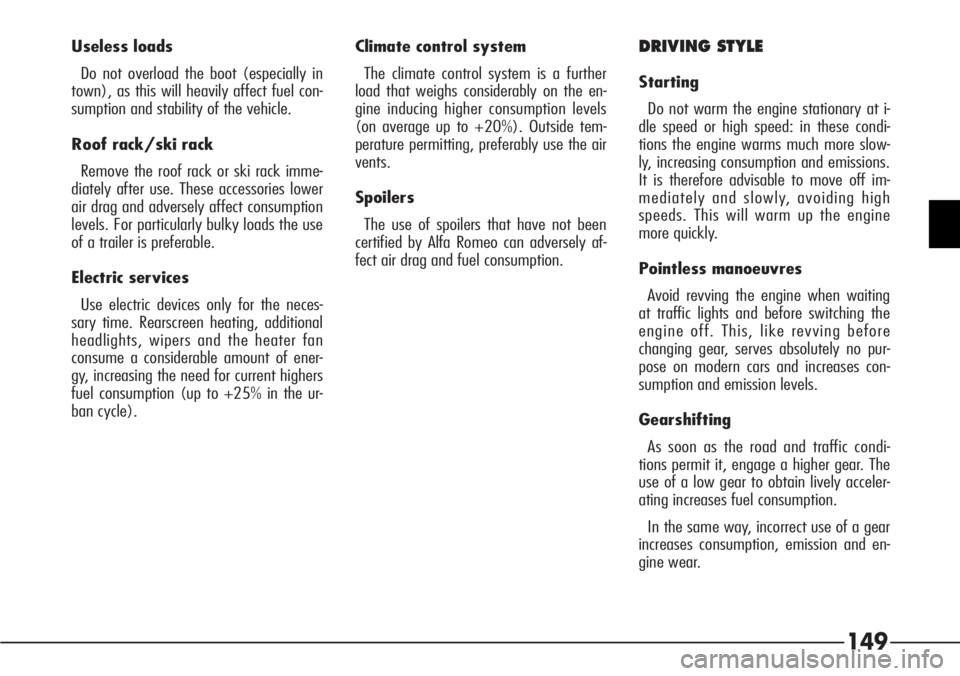
149
Useless loads
Do not overload the boot (especially in
town), as this will heavily affect fuel con-
sumption and stability of the vehicle.
Roof rack/ski rack
Remove the roof rack or ski rack imme-
diately after use. These accessories lower
air drag and adversely affect consumption
levels. For particularly bulky loads the use
of a trailer is preferable.
Electric services
Use electric devices only for the neces-
sary time. Rearscreen heating, additional
headlights, wipers and the heater fan
consume a considerable amount of ener-
gy, increasing the need for current highers
fuel consumption (up to +25% in the ur-
ban cycle).Climate control system
The climate control system is a further
load that weighs considerably on the en-
gine inducing higher consumption levels
(on average up to +20%). Outside tem-
perature permitting, preferably use the air
vents.
Spoilers
The use of spoilers that have not been
certified by Alfa Romeo can adversely af-
fect air drag and fuel consumption.DRIVING STYLE
Starting
Do not warm the engine stationary at i-
dle speed or high speed: in these condi-
tions the engine warms much more slow-
ly, increasing consumption and emissions.
It is therefore advisable to move off im-
mediately and slowly, avoiding high
speeds. This will warm up the engine
more quickly.
Pointless manoeuvres
Avoid revving the engine when waiting
at traffic lights and before switching the
engine off. This, like revving before
changing gear, serves absolutely no pur-
pose on modern cars and increases con-
sumption and emission levels.
Gearshifting
As soon as the road and traffic condi-
tions permit it, engage a higher gear. The
use of a low gear to obtain lively acceler-
ating increases fuel consumption.
In the same way, incorrect use of a gear
increases consumption, emission and en-
gine wear.
Page 151 of 272

150
CONDITIONS OF USE
Cold starting
Brief and frequent cold starts do not al-
low the engine to reach the optimum op-
erating temperature. This leads to a sig-
nificant increase in consumption (from
+15% up to +30% in the urban cycle)
and in the emission of pollutants.
Traffic situations and road
conditions
Rather high consumption levels are
linked with heavy traffic situations, for ex-
ample in slow-moving queues with the
frequent use of low gears or in big towns
with many traffic lights.
Also winding mountain roads and rough
roads adversely affect consumption lev-
els.
Halts in the traffic
During prolonged halts (e.g. level cross-
ings) it is advisable to switch the engine
off.
PROTECTING EMISSION
REDUCING DEVICES
The correct operation of the anti-pollu-
tion devices not only guarantees respect
for the environment but also has a great
influence on vehicle performance.
These devices should be kept in good
condition to permit economical and eco-
logical use of your vehicle.
The programmed Maintenance Schedule
should be carefully followed.
For petrol engines, only unleaded fuel
should be used.
If starting is difficult,
do not insist with pro-
longed attempts. Do not
push, tow or coast start the ve-
hicle: these may all damage the
catalysts. Top speed
Fuel consumption increases considerably
with the speed of the car: it is helpful to
observe that passing from 90 to 120
km/h consumption increases by + 30%.
Also maintain the most uniform possible
speed, avoiding superfluous braking and
accelerating which cost fuel while increas-
ing emission levels. You are therefore ad-
vised to adopt a “smooth” driving style.
trying to anticipate manoeuvres to avoid
imminent danger and respect safety dis-
tances to avoid having to slow down
abruptly.
Acceleration
Violent accelerating bringing the engine
to high rpm has a considerable adverse
effect on consumption and emission lev-
els; it is wise to accelerate gradually with-
out exceeding the maximum permissible
torque.
Page 152 of 272
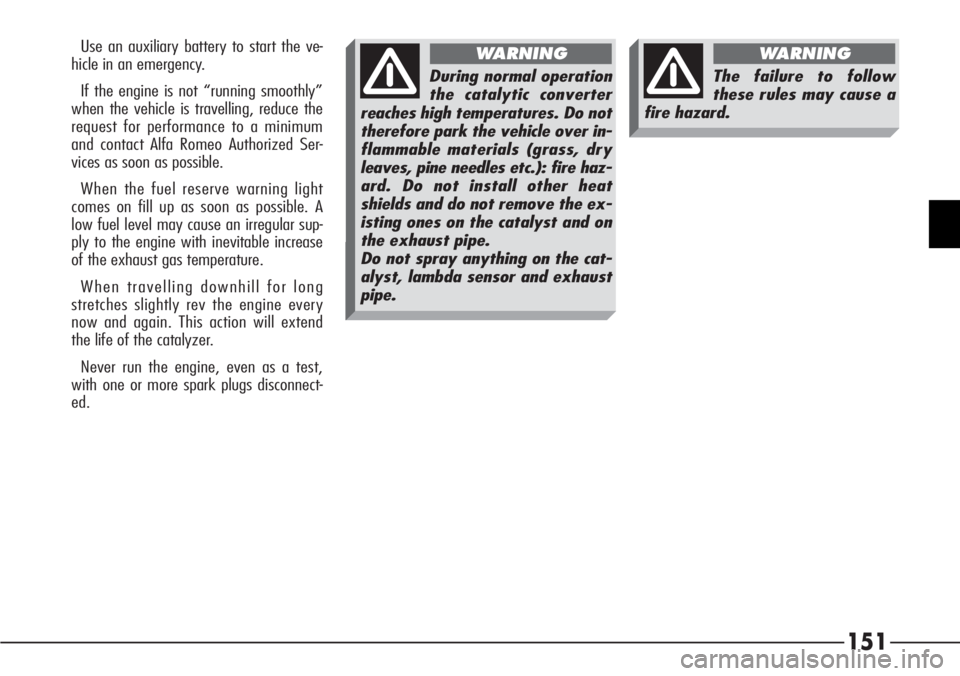
151
Use an auxiliary battery to start the ve-
hicle in an emergency.
If the engine is not “running smoothly”
when the vehicle is travelling, reduce the
request for performance to a minimum
and contact Alfa Romeo Authorized Ser-
vices as soon as possible.
When the fuel reserve warning light
comes on fill up as soon as possible. A
low fuel level may cause an irregular sup-
ply to the engine with inevitable increase
of the exhaust gas temperature.
When travelling downhill for long
stretches slightly rev the engine every
now and again. This action will extend
the life of the catalyzer.
Never run the engine, even as a test,
with one or more spark plugs disconnect-
ed.
During normal operation
the catalytic converter
reaches high temperatures. Do not
therefore park the vehicle over in-
flammable materials (grass, dry
leaves, pine needles etc.): fire haz-
ard. Do not install other heat
shields and do not remove the ex-
isting ones on the catalyst and on
the exhaust pipe.
Do not spray anything on the cat-
alyst, lambda sensor and exhaust
pipe.
WARNING
The failure to follow
these rules may cause a
fire hazard.
WARNING
Page 156 of 272
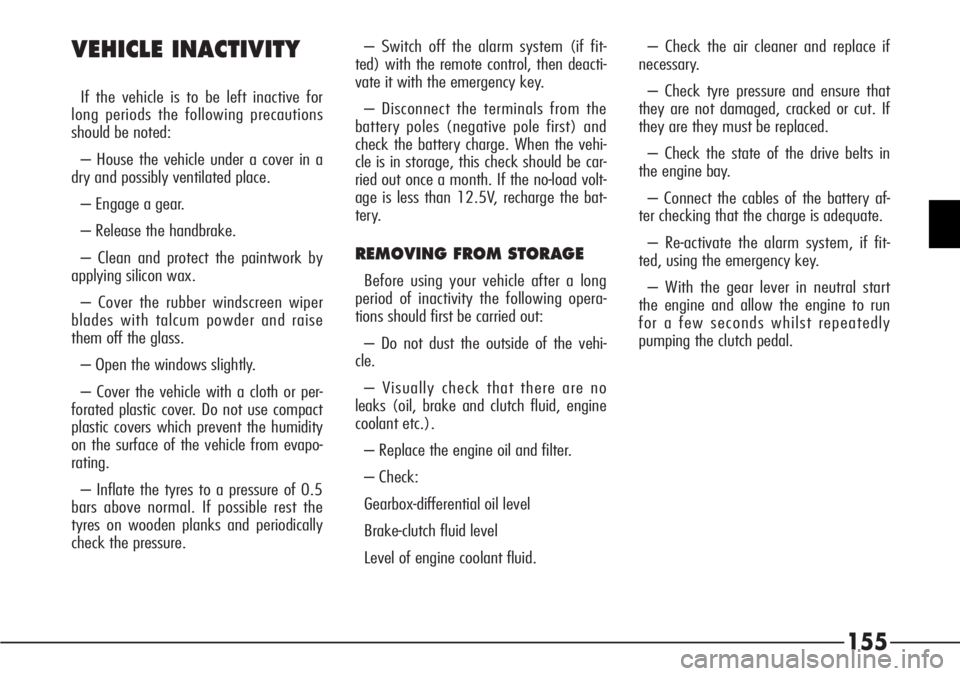
155 VEHICLE INACTIVITY
If the vehicle is to be left inactive for
long periods the following precautions
should be noted:
– House the vehicle under a cover in a
dry and possibly ventilated place.
– Engage a gear.
– Release the handbrake.
– Clean and protect the paintwork by
applying silicon wax.
– Cover the rubber windscreen wiper
blades with talcum powder and raise
them off the glass.
– Open the windows slightly.
– Cover the vehicle with a cloth or per-
forated plastic cover. Do not use compact
plastic covers which prevent the humidity
on the surface of the vehicle from evapo-
rating.
– Inflate the tyres to a pressure of 0.5
bars above normal. If possible rest the
tyres on wooden planks and periodically
check the pressure.– Switch off the alarm system (if fit-
ted) with the remote control, then deacti-
vate it with the emergency key.
– Disconnect the terminals from the
battery poles (negative pole first) and
check the battery charge. When the vehi-
cle is in storage, this check should be car-
ried out once a month. If the no-load volt-
age is less than 12.5V, recharge the bat-
tery.
REMOVING FROM STORAGE
Before using your vehicle after a long
period of inactivity the following opera-
tions should first be carried out:
– Do not dust the outside of the vehi-
cle.
– Visually check that there are no
leaks (oil, brake and clutch fluid, engine
coolant etc.).
– Replace the engine oil and filter.
– Check:
Gearbox-differential oil level
Brake-clutch fluid level
Level of engine coolant fluid.– Check the air cleaner and replace if
necessary.
– Check tyre pressure and ensure that
they are not damaged, cracked or cut. If
they are they must be replaced.
– Check the state of the drive belts in
the engine bay.
– Connect the cables of the battery af-
ter checking that the charge is adequate.
– Re-activate the alarm system, if fit-
ted, using the emergency key.
– With the gear lever in neutral start
the engine and allow the engine to run
for a few seconds whilst repeatedly
pumping the clutch pedal.
Page 169 of 272

168
To replace the bulb (Type D – D1,
35W):
– Remove the engine compartment cov-
er after turning the fastening pins.
– Remove the rubber cap (A-fig. 26)
by pulling the tab (B).– Release the clip (C- fig. 27).
– Remove the bulb (D- fig. 28) and
disconnect the snap-fitted connector (E).– Fit connector to new bulb.
– Fit the bulb in the headlight reflector
making the notch coincide with the corre-
sponding groove.
– Lock the bulb with the clip.
– Fit the rubber cap.
– Refit the engine compartment cover
and fasten turning the fastening pins. Xenon bulbs may only
be touched on the metal
part. If the glass bulb is
touched by the fingers, clean it
carefully with a clean cloth
moistened with methylated spirit
and allow to dry before refitting
the bulb.
Any work on the front
light units should be car-
ried out with the light switch at
position 0 (lights off) and with the
ignition key removed from the
switch: danger of electric dis-
charge.
WARNING
A0D0056m
fig. 26
A0D0057m
fig. 27
A0D0058m
fig. 28
Page 170 of 272

169
High beam headlamp signaller
To replace the bulb (Type D – H1,
55W):
– Remove the engine compartment cov-
er after turning the fastening pins.
– Turn counter-clockwise and remove
the direction indicator bulb holder (A-
fig. 29), without disconnecting the con-
nector to widen the working space.
– Remove the rubber cap (B) by
pulling the tab (C).– Disconnect the snap-fitted connector
(D- fig. 30) and release clip (E).
– Remove the bulb (F- fig. 31).– Fit new bulb in the headlight reflector
making the notches coincide with the cor-
responding grooves.
– Lock the bulb with the clip.
– Fit the connector to the bulb.
– Fit the rubber cap.
– Fit the direction indicator bulb holder
and lock it by turning it clockwise.
– Refit the engine compartment cover
and secure it by turning the fastening
pins.
A0D0059m
fig. 29
A0D0060m
fig. 30
A0D0061m
fig. 31
Page 171 of 272

170
Front sidelights
To replace the bulb (Type B – H6W,
6W):
– Remove the engine compartment cov-
er after turning the fastening pins.
– Turn counter-clockwise and remove
the direction indicator bulb holder (A-
fig. 32) without disconnecting the con-
nector to widen the working space.
– Remove the rubber cap (B) by
pulling the tab (C).– Press the two retaining tabs and re-
move the bulb holder (D- fig. 33).
– Remove the bulb (E- fig. 34) from
the bulb holder, pushing it slightly and
turning it counter-clockwise.– Fit the new bulb into the bulb holder,
pushing it slightly and turning it clock-
wise.
– Push the bulb holder down in its seat.
– Fit the rubber cap.
– Fit the direction indicator bulb holder
and lock it by turning it clockwise.
– Refit the engine compartment cover
and secure it by turning the fastening
pins.
A0D0059m
fig. 32
A0D0062m
fig. 33
A0D0063m
fig. 34